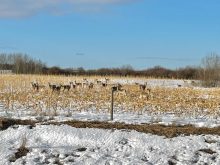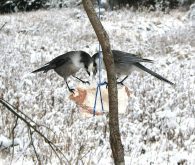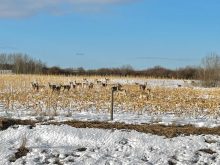My September calendar always sets aside a few days for a duck hunting trip with my son. On those days we haunt the marshes, which we find more interesting than going after birds feeding in fields. Our chosen setting means that, when the ducks aren’t flying, we can enjoy time spotting other wetland wildlife.
Last year’s hunt near Brandon was no exception. On the very first evening, we were thrilled to see five great egrets in a shallow marsh close to our hunting spot. We got an even closer look near the end of the day.
As the evening light was fading and we waded out to pick up our decoys, a lone egret made a fly-by and, for some strange reason, landed only a few metres from us.
Read Also

Finally getting paid for sustainable farming?
Alberta project says they might have a line on a workable ecosystem credit model to reward farmers for sustainability, and Manitoba might be next
- READ MORE: Trumpeting victory for swan conservation
- READ MORE: Clawing back Manitoba’s sturgeon
- READ MORE: Wildlife stories in the snow
Like their close cousins, the great blue heron, egrets aren’t normally that trusting. We jokingly wondered if it enjoyed the entertainment of us struggling through the boot-sucking muck — a form of penance, perhaps, for the birds we had just taken for our dinner plates.
By the time we were done, we were only about 10 metres away from our watcher, at which point it seemed to have enough of the game and lifted off with the graceful wing flourish that only birds in the heron family seem to achieve.

The next day, we dragged ourselves out of bed at 4:30 a.m. for a hunt on a large marsh west of Brandon. Once again, the ducks were in abundance, but this time they were scattered among a greater cacophony of Franklin’s gulls, blackbirds and shorebirds.
During one lull in the hunting action, we watched some darker birds working their way toward us. We initially thought they were cormorants, a common sight in larger wetlands. As they got closer, however, I noticed their different body shape and distinctive bill. We were being treated to a sighting of the white-faced ibis, a smaller relative of great blue herons and great egrets.
In the two mornings that we hunted this marsh, we saw about 10 groups of the species each day. We figured the shallow flooded marsh suited their feeding needs.
March of the waders
The great egret and white-faced ibis have gone from rare birds to a fairly common sight in parts of Manitoba over the last three decades. I love seeing them, but I also became curious about their expansion into the province.

The great egret is a smaller, sleeker, pure-white version of a great blue heron and, like their cousins, great egrets nest in colonies, usually in groves of large trees close to large wetlands.
They have been poking around in Manitoba since the 1950s, but their numbers started to increase significantly in the last 20 years. In the 1970s, a lone colony at Dog Lake in the Interlake region was the extent of their presence in Manitoba. That group was a bit of an oddity, hundreds of kilometres north of other known colonies.
These birds often move around in the late summer and fall before finally migrating.
My first sighting, in the Baldur area in the 1980s, was likely a lone wanderer not associated with any breeding colony. I spotted the occasional bird over the following decades, but I have not had anywhere near the sightings – 20 birds in three different marshes — that we did last fall.

These days, the number of known egret nesting colonies has grown and includes sites in the southwest and the Interlake. As for white-faced ibises, which nest on mounds of marsh vegetation in shallow flooded areas, often alongside other marsh nesters like Franklins gulls, the main nesting area seems to be Whitewater Lake in the southwestern corner of the province, but there are likely more locations we don’t know about.
















